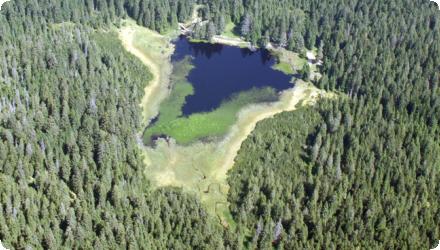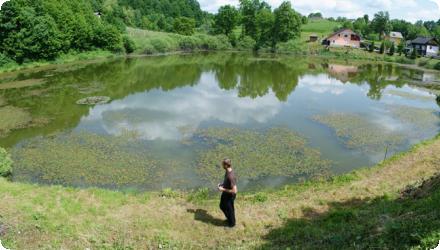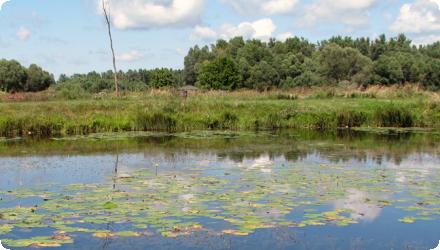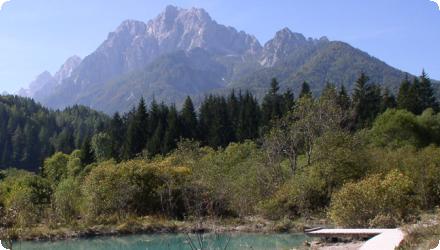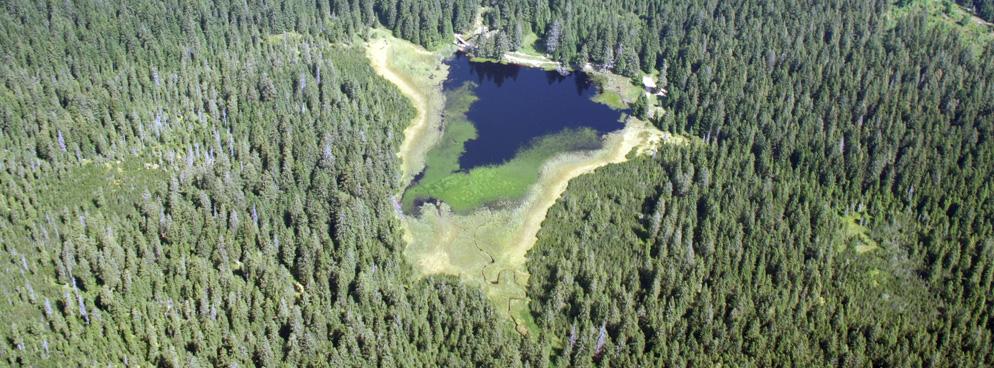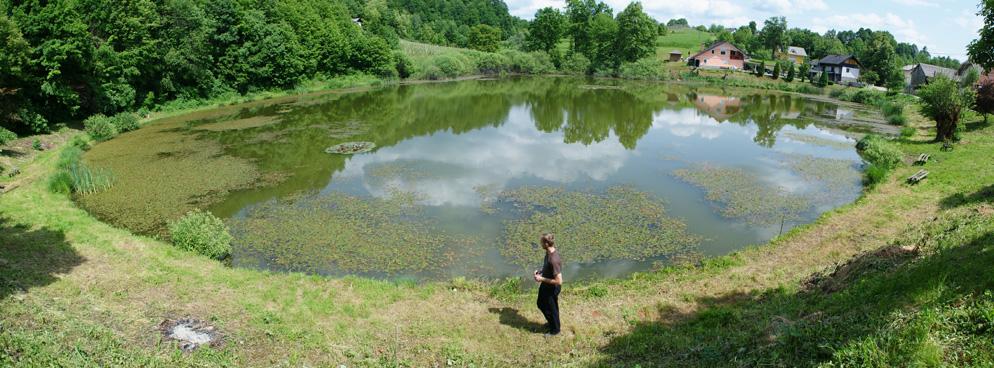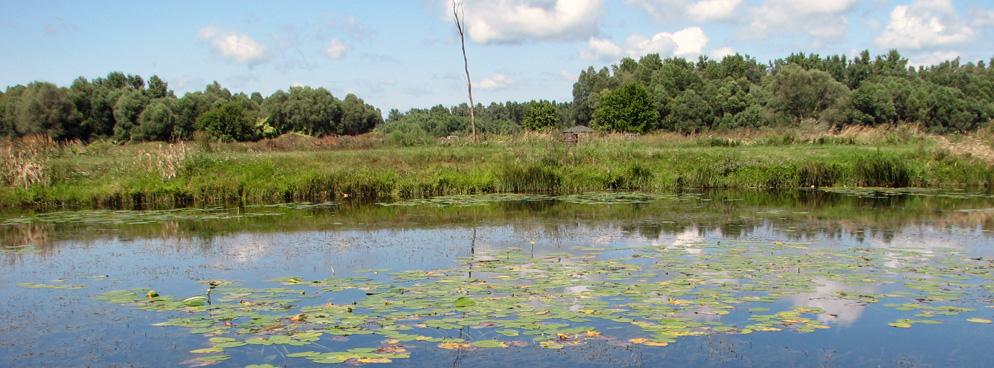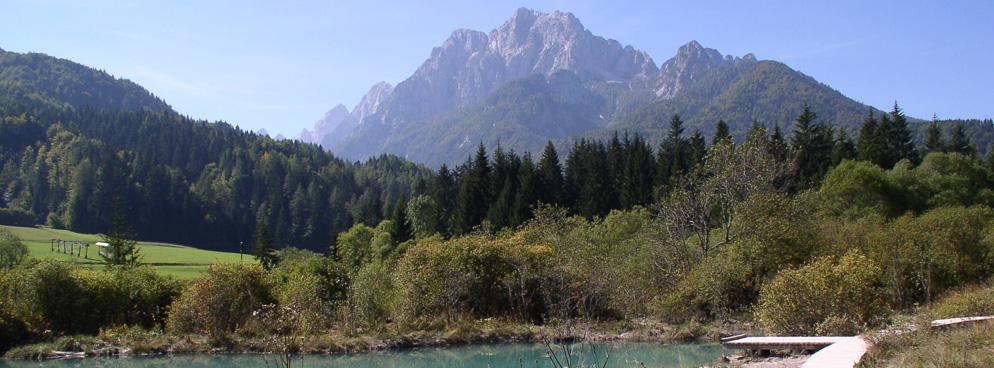Last update
2025
Summary
The LIFE WETMAN project (2011–2015) restored six Slovenian wetlands (Pohorje bogs, Zelenci, Mura–Petišovci oxbows, Gornji kal, Planik and Vrhe). It improved hydrological conditions (e.g., dams on outflows in the Pohorje bogs and a gravel/sediment trap on the Čošelnov graben feeding Zelenci), removed overgrowth, and eliminated invasive fish in Gornji kal and the Mura oxbows. To reduce habitat damage and disturbance, footpaths/boardwalks were created in Zelenci and on the Pohorje bogs. Site-specific management guidelines were prepared and integrated into sectoral and Natura 2000 planning to ensure long-term conservation.
After LIFE, implementation continued: a Zelenci management plan was prepared in 2013 with the municipality; the national Natura 2000 Management Programme (2015–2020) and the integrated project LIFE-IP NATURA.SI (2018–2026) have supported further measures and monitoring. On Pohorje, follow-up regional projects (SUPORT and POHORKA, 2019–2023) consolidated habitat and visitor-management actions. WETMAN’s results were also recognised with a Best LIFE Nature award at EU Green Week.
After LIFE, implementation continued: a Zelenci management plan was prepared in 2013 with the municipality; the national Natura 2000 Management Programme (2015–2020) and the integrated project LIFE-IP NATURA.SI (2018–2026) have supported further measures and monitoring. On Pohorje, follow-up regional projects (SUPORT and POHORKA, 2019–2023) consolidated habitat and visitor-management actions. WETMAN’s results were also recognised with a Best LIFE Nature award at EU Green Week.
Position
Latitude
46.50361
Longitude
15.45305
Project
NWRM
National Id
Slovenia_08
Installation date
2015-02
Implementation Status
Contact
REC
Transboundary
0
Photo gallery
Location of the project
Multi-site LIFE WETMAN actions across Slovenia :
Zelenci (Kranjska Gora): just after Podkoren, south side of main road 202, with car park on the left when driving from Kranjska Gora.
Mura oxbows near Petišovci (Lendava): on the Mura floodplain by Petišovci settlement at the Slovenia–Croatia border; works at Nagy Parlag, Muriša, Csiko Legelo.
Gornji kal (Bela krajina): between Hrast pri Vinici and Perudina, three karst ponds (Gornji kal, Krivače, Kršeljivec).
Zelenci (Kranjska Gora): just after Podkoren, south side of main road 202, with car park on the left when driving from Kranjska Gora.
Mura oxbows near Petišovci (Lendava): on the Mura floodplain by Petišovci settlement at the Slovenia–Croatia border; works at Nagy Parlag, Muriša, Csiko Legelo.
Gornji kal (Bela krajina): between Hrast pri Vinici and Perudina, three karst ponds (Gornji kal, Krivače, Kršeljivec).
Project's objectives
Restore hydrology of peatlands/mires and oxbows
Reduce overgrowth on priority wetland habitats at Zelenci, Vrhe, Planik and selected Mura oxbows/Gornji kal sites.
Remove invasive fish: eradicate Silurus glanis from Hrast pond (Gornji kal) to re-establish 1.2 ha of suitable pond-turtle habitat; remove Ctenopharyngodon idella, Micropterus salmoides, Pseudorasbora parva from three Mura oxbows to re-establish 2.7 ha of habitat for target taxa (Umbra, Emys, Bombina, Triturus, Leucorrhinia pectoralis).
Limit habitat destruction/disturbance by building boardwalks/footpaths in Zelenci and on Pohorje and by organising visitor management/monitoring.
Embed conservation in planning: prepare site management guidelines and integrate them into sectoral/Natura 2000 plans (covering 4,439 ha across 6 SCIs and 2 SPAs).
Reduce overgrowth on priority wetland habitats at Zelenci, Vrhe, Planik and selected Mura oxbows/Gornji kal sites.
Remove invasive fish: eradicate Silurus glanis from Hrast pond (Gornji kal) to re-establish 1.2 ha of suitable pond-turtle habitat; remove Ctenopharyngodon idella, Micropterus salmoides, Pseudorasbora parva from three Mura oxbows to re-establish 2.7 ha of habitat for target taxa (Umbra, Emys, Bombina, Triturus, Leucorrhinia pectoralis).
Limit habitat destruction/disturbance by building boardwalks/footpaths in Zelenci and on Pohorje and by organising visitor management/monitoring.
Embed conservation in planning: prepare site management guidelines and integrate them into sectoral/Natura 2000 plans (covering 4,439 ha across 6 SCIs and 2 SPAs).
Involved Partners
| Authority type | Authority name | Role | Comments |
|---|---|---|---|
Climate zone
warm temperate moist
Temperature
10.2°C
Precipitation
1065
Annual rainfall range
900 - 1200 mm
Elevation range
765 m
Vegetation class
Bogs and fens (peatland communities) across pilot areas: active/transition mires on Pohorje and Zelenci, and alkaline fens / wet meadows at Vrhe/Planik; aquatic/riparian vegetation around Mura oxbows and karst ponds at Gornji kal. If a single class is required: “bog & fen communities (peatlands).”
Water bodies: Ecological Status
Depends on the site
Water bodies: Chemical Status
Depends on the site
Water quality status
eutrophication (agriculture), invasive fish introductions, waste dumping
Project scale
Micro
Project scale specification
A network of six discrete pilot sites across Slovenia where site-specific actions (small hydromorphological works, invasive-fish removal, visitor-management boardwalks) were implemented to restore local wetland habitats; the project does not operate at river-basin or national planning scale.
Total cost
€2,144,376
Costs total information
LIFE09 NAT/SI/000374 WETMAN (2011-2015)
Costs capital
2144376
Financing authorities
Type of funding
EU-funds: LIFE+
Comments
€1,072,188
Type of funding
National funds
Comments
€563,095
Type of funding
Local funds
Comments
Črnomelj €12,000; Maribor €4,000; Zreče €4,000; Slovenjska Bistrica €3,000; Slovenj Gradec €2,500; Lovrenc na Pohorju €2,000.
Compensations
0
Policy context
Slovenian wetlands had been degraded by drainage and hydro-amelioration, canalisation of rivers, and the loss of appropriate management; this drove peatland drying and overgrowth. Tourism/visitor pressure damaged sensitive habitats, and invasive fish introductions altered oxbow and pond biocenoses; around some oxbows, intensive agriculture reached the water’s edge. Mapped to WFD: hydromorphological alteration (drainage, channelisation), biological pressure: invasive alien species, and diffuse agricultural pressure (nutrients/eutrophication risk) where farming abuts oxbows.
Land ownership
Mixed ownership across sites: state, municipal and private land. During permitting the team obtained 41 landowner consents and permissions from the Farmland & Forest Fund of the Republic of Slovenia (state land manager) and municipalities.
Community involvment
No
Design consultation activity
| Activity stage | Name | Key issues | Comments |
|---|---|---|---|
|
Implementation phase
|
Formal engagement included 91 meetings with municipalities, 44 with ministries/ARSO, 17 with the Agricultural & Forestry Chamber, 36 with farmers/hunters/fishers, plus one workshop with the police.
|
Improving local capacity for sustainable land and visitor management.
|
|
|
Implementation phase
|
56 public events, 45 school/youth events (reaching 2,293 children and youth), 13 photo exhibitions; a TV documentary and 3 TV spots by RTV Slovenia.
|
For the general public and schools
|
Policy target
| Target purpose |
|---|
|
Improved Biodiversity
|
|
Increase Water Storage
|
Policy pressure
| Pressure directive | Relevant pressure |
|---|
Policy impact
| Impact directive | Relevant impact |
|---|
Requirement directive
| Requirement directive | Specification |
|---|
Contractual arrangements
0
| Arrangement type | Responsibility | Role | Name | Comments |
|---|
Part of wider plan
0
Wider plan type
| Wider plan type | Wider plan focus | Name | Comments |
|---|
ZRSVN coordinates ongoing monitoring of hydrology (piezometers/outflow), water quality at Zelenci, visitor pressure on Pohorje, and target taxa (amphibians, birds, Emys, Odonata, habitats), via contracted specialists and integration with national schemes.
Hydrology: groundwater water-table levels (piezometers), outflow from restored mires (e.g., Vrhe).
Water quality (Zelenci): physico-chemical parameters (nitrates, phosphates, chlorides) and biological indicators (algae).
Biota: amphibians, birds, European pond turtle (Emys orbicularis), dragonflies (Odonata), habitat types incl. Liparis loeselii; fish status reported for Umbra krameri in Mura oxbows.
Visitors: counts/flow used to manage trampling/pressure on Pohorje sites.
Water quality (Zelenci): physico-chemical parameters (nitrates, phosphates, chlorides) and biological indicators (algae).
Biota: amphibians, birds, European pond turtle (Emys orbicularis), dragonflies (Odonata), habitat types incl. Liparis loeselii; fish status reported for Umbra krameri in Mura oxbows.
Visitors: counts/flow used to manage trampling/pressure on Pohorje sites.
Maintenance
Long-term maintenance is ensured by 10-year contracts (gravel-trap emptying at Zelenci, mowing at Gornji kal, site management at Vrhe/Planik) plus municipal/ARSO programmes for sediment-trap cleaning and routine path/boardwalk upkeep.
On Pohorje, 2,362 m of wooden footpaths and a visitor-monitoring system were installed; in 2012 the three bog sites received >55,000 visits (Lovrenška bogs >33,000/yr, 1,471 max/day). Footpaths canalised visitors and reduced trampling/disturbance on sensitive habitats.
The project generated >200 media articles and >560 events (meetings, workshops, public actions).
Construction/maintenance works on Pohorje involved >616 effective volunteer work-days (mountaineering clubs, tourist & hunting associations, municipal reps, armed forces, scouts, individuals).
In addition, outreach actions organised 19 volunteer events totalling 1,182 volunteer-days.
Zelenci Management Plan was prepared and approved by the Kranjska Gora municipal council, setting a long-term framework (to 2030) with five-year operator work plans for reserve management and visitor use.
The project generated >200 media articles and >560 events (meetings, workshops, public actions).
Construction/maintenance works on Pohorje involved >616 effective volunteer work-days (mountaineering clubs, tourist & hunting associations, municipal reps, armed forces, scouts, individuals).
In addition, outreach actions organised 19 volunteer events totalling 1,182 volunteer-days.
Zelenci Management Plan was prepared and approved by the Kranjska Gora municipal council, setting a long-term framework (to 2030) with five-year operator work plans for reserve management and visitor use.
Information on retained water
Pohorje bogs: 111 wooden dykes installed on drainage/outflow channels (Javorski vrh 17; Klopnovrška 25 type-A + 64 type-B; Lovrenška 5) and 6 new waterholes (2 Javorski vrh, 4 Klopnovrška). Monitoring with 20 piezometers at two sites showed groundwater levels rose and fluctuated less after works. Hydrology improved across Klopnovrška 12.29 ha (+4.15 ha buffer = 16.44 ha), Javorski vrh 2.4 ha, Lovrenška 84 ha.
Zelenci (springs of Sava Dolinka): Built a gravel/sediment barrier 110 m long, 220 m³ capacity on Čošelnov graben; expected to prevent further gravel accumulation and hydrological change over 54.55 ha of wetland.
Vrhe: Constructed a dam and distribution channel to re-spread water across the fen; added two culverts to stop road-gravel deposition.
Gornji kal (karst ponds): Bank re-profiling and renewal of ponds (Krivače 0.4 ha; Hrast 0.7 ha; Kršeljivec 1.3 ha) improved water regime; Emys habitat improved over 18.5 ha; succession slowed.
Mura–Petišovci oxbows: Deepened Nagy Parlag (2.6 ha) and Csiko Legelo (0.8 ha) to ~2.5 m; moved ~27,000 m³ spoil to Lakoš gravel pit, creating 3.75 ha of new habitat on spoil banks; hydrology of the wider oxbow area improved over 31.3 ha.
Zelenci (springs of Sava Dolinka): Built a gravel/sediment barrier 110 m long, 220 m³ capacity on Čošelnov graben; expected to prevent further gravel accumulation and hydrological change over 54.55 ha of wetland.
Vrhe: Constructed a dam and distribution channel to re-spread water across the fen; added two culverts to stop road-gravel deposition.
Gornji kal (karst ponds): Bank re-profiling and renewal of ponds (Krivače 0.4 ha; Hrast 0.7 ha; Kršeljivec 1.3 ha) improved water regime; Emys habitat improved over 18.5 ha; succession slowed.
Mura–Petišovci oxbows: Deepened Nagy Parlag (2.6 ha) and Csiko Legelo (0.8 ha) to ~2.5 m; moved ~27,000 m³ spoil to Lakoš gravel pit, creating 3.75 ha of new habitat on spoil banks; hydrology of the wider oxbow area improved over 31.3 ha.
Information on Water quality overall improvements
The Zelenci barrier intercepts coarse load/sediment before it reaches the reserve (process protection stated); no numeric water-chemistry results reported in accessible WETMAN summaries.
1
Overgrowth removal and habitat structure restoration on Mura oxbows 3.33 ha (Nagy Parlag 2.55 ha; Csiko Legelo 0.78 ha) → biodiversity increased in final inventories.
Invasive fish control: At Hrast pond, removed 525 alien fish (92 kg) in spring 2012; regular angling removed 22 carp (200 kg) and 11 Wels catfish (146 kg); Wels density reduced significantly but not fully eradicated.
Target species habitat gains: Emys orbicularis habitat improved (1.2 ha at Hrast; site-wide 18.5 ha including banks/nesting areas); creation of shallow margins, peninsulas, islands at Krivače/Hrast; new habitat on Lakoš spoil banks (3.75 ha) for taxa incl. Leucorrhinia pectoralis, Umbra krameri, Bombina bombina, Triturus carnifex.
Pohorje bog vegetation & fauna: Raised water tables and dyke system expected to slow/stop shrub/tree encroachment; works benefited active raised bogs and transition mires and capercaillie/black grouse habitats; 2,362 m of boardwalks channelled visitors, reducing trampling; >55,000 visits counted across three bogs in 2012 (Lovrenška >33,000/yr; 1,471 max in a day).
Invasive fish control: At Hrast pond, removed 525 alien fish (92 kg) in spring 2012; regular angling removed 22 carp (200 kg) and 11 Wels catfish (146 kg); Wels density reduced significantly but not fully eradicated.
Target species habitat gains: Emys orbicularis habitat improved (1.2 ha at Hrast; site-wide 18.5 ha including banks/nesting areas); creation of shallow margins, peninsulas, islands at Krivače/Hrast; new habitat on Lakoš spoil banks (3.75 ha) for taxa incl. Leucorrhinia pectoralis, Umbra krameri, Bombina bombina, Triturus carnifex.
Pohorje bog vegetation & fauna: Raised water tables and dyke system expected to slow/stop shrub/tree encroachment; works benefited active raised bogs and transition mires and capercaillie/black grouse habitats; 2,362 m of boardwalks channelled visitors, reducing trampling; >55,000 visits counted across three bogs in 2012 (Lovrenška >33,000/yr; 1,471 max in a day).
Key lessons
Consensus-based planning pays off. The conservation guidelines and the Zelenci management plan were co-created through facilitated, bottom-up workshops, which made later implementation easier and better accepted.
Hydrological restoration needs time. Monitoring showed groundwater levels rose and became more stable on restored bogs, but the report stresses that full ecological responses to water-regime works will manifest over a longer period beyond the project end.
Managing people is as critical as managing water. Heavy visitation on Pohorje required visitor monitoring and 2,362 m of boardwalks to channel use and reduce trampling, combining infrastructure with education and outreach.
Invasive species control is rarely “one-and-done”. Intensive removal reduced alien fish (incl. Silurus glanis) but did not fully eradicate them, so ongoing fishery management and rules were built into plans.
Pragmatism with permissions and land matters helps. Where planned land purchase proved impractical, the team redesigned the Zelenci gravel-barrier solution and navigated a wide suite of permits and owner consents to keep delivery on track.
Hydrological restoration needs time. Monitoring showed groundwater levels rose and became more stable on restored bogs, but the report stresses that full ecological responses to water-regime works will manifest over a longer period beyond the project end.
Managing people is as critical as managing water. Heavy visitation on Pohorje required visitor monitoring and 2,362 m of boardwalks to channel use and reduce trampling, combining infrastructure with education and outreach.
Invasive species control is rarely “one-and-done”. Intensive removal reduced alien fish (incl. Silurus glanis) but did not fully eradicate them, so ongoing fishery management and rules were built into plans.
Pragmatism with permissions and land matters helps. Where planned land purchase proved impractical, the team redesigned the Zelenci gravel-barrier solution and navigated a wide suite of permits and owner consents to keep delivery on track.
Success factor(s)
| Success factor type | Success factor role | Comments | Order |
|---|---|---|---|
|
Successful coordination between authorities
|
main factor
|
Bottom-up, cross-sector process that produced conservation guidelines integrated into forestry, fishery, hunting and municipal plans. |
|
|
Public participation
|
main factor
|
Strong monitoring and adaptive feedback (piezometers, visitor counts) informing management |
|
|
Conducted assessments (incl. economic)
|
secondary factor
|
Long-term “After-LIFE” arrangements (four 10-year maintenance contracts and two 10-year bank warranties) to secure upkeep. |
|
|
Communication activities
|
main factor
|
High visibility and engagement (media, schools, >1,100 volunteer-days) building social licence. |
Driver
| Driver type | Driver role | Comments | Order |
|---|
Transferability
Highly transferable to small wetland restorations (bogs, fens, oxbows, ponds): simple hydrological works (wooden dams, small berms, gravel/sediment traps), invasive-fish control, and visitor management worked when paired with local plans and After-LIFE maintenance. Look carefully at land/permit complexity, upstream sediment sources, incomplete IAS eradication, hydrological time-lags, and the need for long-term monitoring.
Source(s)
English
